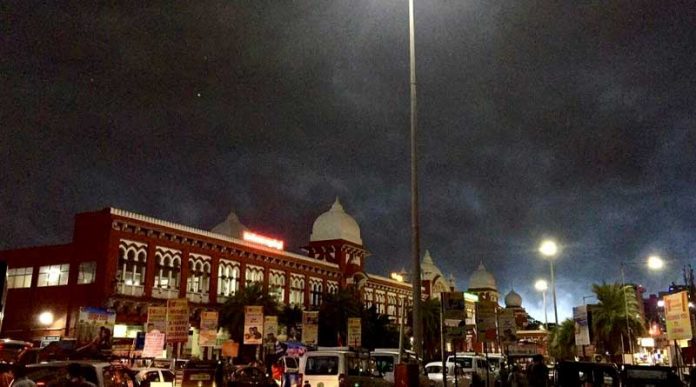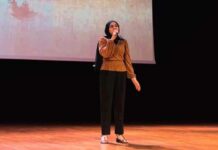I let myself mirror the world passing in front of me. The silence filled with noise. The serene filled with chaos. The perfect filled with imperfections. The world as it is.
We entered the bustle of the Chennai Egmore Railway Station with more bags than we could carry. Each person from my family carried a bag or two, balancing it on our fists, arms and shoulders. A porter rushed to us, quickly calculating that he could make his day’s worth of income just by carrying the bags of my family of nine from one platform to another. He demanded a 500 Rupees wage to carry five bags of the many we had. It roughly converts to just 25 Dirhams, which my mother would spend on a Starbucks drink in the blink of an eye, but her Indian upbringing made her bargain with him. They settled on 400 Rupees, which was still an overpay in comparison to the regular stipend he would earn. The stereotype that Indians do not travel light is true. The stereotype that they bargain in any way they could is also true.
The train we were boarding was on Platform 7, two flights of grimy stairs and a long manky metal walkway bridge away. It is always a hectic journey to travel on the Indian Railways. However, a sense of excitement imbues within the journey. The amalgamation of people from the crooks and corners of the diverse India, the place brings together everyone, a Maharashtrian lady adorned with unpolished gold nose pins on both sides of her nostrils and a Tamil street vendor with a basket of fresh mangoes beside her wearing black thread, ornaments next to one another on the stone bench waiting for their train to arrive. They both wore the same nine yards of saree but in different ways, and that was the only difference in them that the railway station allowed for. I, wearing a black abaya with an iPhone in my hand and a Louis Vuitton bag across my torso, got help from a transgender woman to carry my heavy suitcase up the staircase. She smiled at me after she handed me back my bag and blessed me with her palm on my head before she walked away. I was reminded of the unconditional, unadulterated unity that ties the Indian society together.
Reaching Platform 7 after the gruelling walk, my mother made sure we got all the bags transported safely. We entered the air conditioned coach of the stationed train. The stench of the toilet whooshed past me as I walked across the non-AC coach, which is right next to the one we boarded onto. I then awaited a 12 hour train journey stretching across a distance of 600 kilometres from Chennai to the province of Ramanathapuram, my hometown, in this train.
I usually stand at the door through the night when we travel in the train. It is my annual escape, a night I yearn for all year. It lets me reflect on where I have come from and where I am at the moment. The differences of India. So contrasting yet so similar. The fragrance of wet soil and teeming green fields whirred in the air as I gazed at the village landscapes in front of me like a film running in fast motion. The glow of the moon soared through the thick clouds and spotlighted my face. I raised my phone in front of me to take a selfie, and a figure looked into my camera from behind me.
“Ma? Could you move a bit?” I heard a mellow, honeyed voice.
A man a wearing a shimmering silver sequin embedded top and a ruffled red short skirt looked at me. He had his long hair up in a pony tail and wore bright pink rouge and matching lipstick and had smudged red and blue eyeshadow across his lids. His dark skin was the perfect canvas to highlight the pop of vivid colours on his face. He also wore his smile beautifully as he waited for me to move.
Pandian is a street dancer from the Dalit community who performed along with women, during festivals. He told me he was on his way back home to the village of Puliyankulam in the district of Tirunelveli, a 170 kilometres from Ramanathapuram.
“So, are you a performer?” I asked in Tamil a few minutes after conversing with him.
“I am an artist. I’ve been performing as a street dancer ever since I was 17 and I am 56 years old now. This is my job and I don’t know anything else.”
I asked him if he was offended that I asked him if he was a dancer at weddings, and he answered with a no, and a grin. “I’ve been subjected to so much humiliation because of people not being able to recognize the nature of my job. It makes me happy that a beautiful girl like you tried to understand me,” he told me as his eyes started to brim with tears.
The tears were an embodiment of his struggles as someone belonging to a marginalized community. He didn’t let them flow onto his cheeks. Like how he has never voiced out his anguish to anybody. He told me that he hasn’t spoken to a stranger for this long in years. The tears, nevertheless, spoke of tales that he couldn’t verbalize as words.
“I’m not rich and beautiful like you. I don’t have a phone like you. You are also like me, a Muslim minority, but you are from Dubai,” he said.
The caste based discrimination against the Dalits in India is one that is embedded into the society. It lingers at every small institution of the paradigm. While I only saw the beauty of togetherness at the railway station when I entered into it, Pandian’s puddled drops of tears made me realize that I was blind to the intricacies of the bigotry present at the station, and in the Indian society.
“Look past your glasses ma, you’ll see,” Pandian told me as he alighted from the train.


















